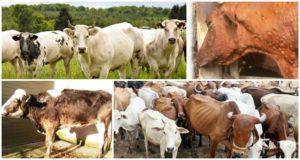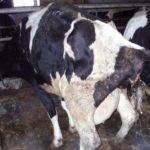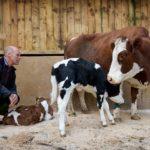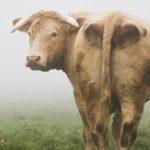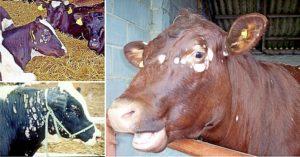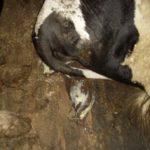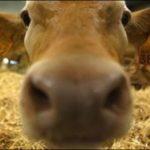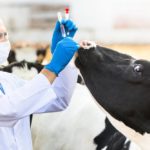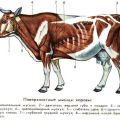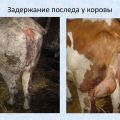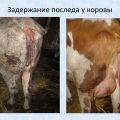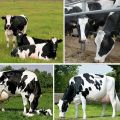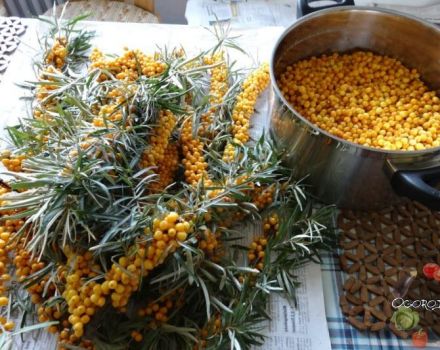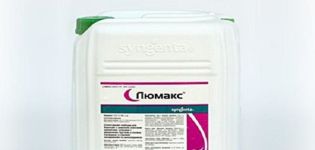Types and symptoms of endometritis in cows, treatment regimen and prevention
Endometritis is a disease that causes a lot of concern for the farmer. With endometritis, the middle layer of the cow's uterine wall becomes inflamed, which leads to possible infertility and even death of the animal. Treatment of endometritis in cows includes symptomatic and antibiotic therapy and lasts at least 2 weeks. The prognosis for the disease is cautious, with a high risk of possible complications.
The main causes of endometritis in cows
Endometritis is caused by bacteria of the genus Escherichia and Trueperella, which are normally found in the body in the intestines and on the surface of the skin, and are considered opportunistic. When bacteria enter the sterile uterus, they cause severe inflammation, affecting the inner layer of the wall - the endometrium.
Bacteria can enter the uterus in various ways - with improper sterilization of gynecological instruments, violation of the calving technique, artificial insemination, vaginal and rectal examination. Endometritis can provoke concomitant diseases of the genitourinary system. Old or sick cows or cows that have received malnutrition during pregnancy and childbirth are especially susceptible to pathology.
Disease types
There are several types of the disease. The most common myometritis is an inflammation of the muscular membrane of the uterine wall. Doctors call perimetritis a threatening pathology - inflammation of the mucous membrane and surrounding tissues. The mucous membrane is very sensitive to the action of pathogenic factors and is poorly restored, and this can also cause inflammation of nearby organs.

Purulent-catarrhal endometritis is distinguished by the characteristic discharge from the vagina - yellow, brown or brown, with an abundant content of mucus. Acute metritis appears immediately after childbirth, characteristic signs can be seen the very next day. Fibrous endometritis has another name - chronic endometriosis. The sensitive mucous membrane is gradually replaced by coarse fibrinous tissue, which sharply decreases the fertility of the cow.
The main symptoms
At first glance, one can say about the poor health and oppression of the animal. The cow stands in the corner, does not touch the hay or water, breathes heavily. There is no chewing gum.The disease can be accompanied by sudden weight loss. Milk stops being produced or is produced in reduced quantities. Discharge of mucus from the vagina is characteristic. Depending on the type of endometritis, mucus can be of different colors - from transparent to brown, reddish. If mucus collects in flakes and squeaks on the fingers, then this is a sure sign of beginning fibrous endometritis.
With a rectal examination, an increase in local and general temperature is clearly felt, the uterus can be enlarged.
The cow is standing in an unnatural position, as if about to start urinating. The animal can react aggressively to people, moan in pain.
Diagnostics
For the diagnosis of endometritis, an external clinical examination, anamnesis, vaginal and rectal examinations are used. Additionally, cultures of pathological material are taken in order to determine the exact type of pathogen and to carry out appropriate treatment. Sometimes a complete blood count is required.
It is important to diagnose the disease at an early stage. Failure to start treatment on time can adversely affect the cow's reproductive system and lead to infertility. This approach brings huge economic losses to the farm, so all animals must be examined daily by a veterinarian or service personnel.
Treatment regimen for endometritis in cows
Endometritis treatment includes the use of antibiotics as the main component of therapy. Antimicrobial drugs successfully cope with Escherichia and other microorganisms, restoring the natural sterility of the uterus. But this also destroys the vaginal microflora, which maintains a normal acid balance for the passage of sperm. Therefore, after antibiotic treatment, cows are unsuitable for insemination for 2-3 months.

Antimicrobial therapy
Antimicrobial drugs in this case are antibiotics intended for gram-negative bacteria. In Europe, Ceftiofur and Cefapirin have been used for a long time. The substances are perfectly tolerated by the cow's body and do not harm the animal.
Antibiotics are diluted in a sterile solution and administered intrauterinely. The preparations can even be given to a lactating cow, and the milk is not utilized, but fed to the calves. The approach is considered to be economical and efficient, especially for small farms.
Prostaglandins, hormone-like substances that stimulate the production of the corpus luteum, have also become widespread. The cow comes into heat faster and recovers from a serious illness. Within a month after the onset of the disease, the animal can be considered fully recovered. The preparations "Estrofan" and "Luteostenol" combine antibiotics and prostaglandins and have a double effect on recovery.
Antiseptic treatment
For antiseptic treatment of the uterus, the drug "Sepranol", which is widely used in veterinary medicine, has proven itself well. "Sepranol" is diluted in sterile water or saline and injected intrauterinely using a catheter. To prevent the recurrence of the disease, you can use "Uteroton", which destroys repeated foci of bacterial growth. The medicine works immediately and hardly affects the kidneys and liver.
A cow can be treated with propranolol, which is contained in several preparations, both domestic and foreign. The course of therapy lasts 3-4 weeks, and at least the same amount of time should not be consumed with animal meat and milk. It is allowed to feed food to carnivores, and in the last stages of treatment - to give milk to calves in the form of cottage cheese.
Preventive actions
Prevention of endometritis consists in strict adherence to the technique of artificial insemination, calving and vaginal examination.It is unacceptable to use dirty or non-sterile instruments, to take one gynecological speculum for several cows, to deliver in an unsuitable room. Long before calving, the cow is transferred to a special delivery box, which is daily treated with disinfectants. The same applies to the postpartum premises. In advanced farms, special quartz lamps are used for sterilization.
Before starting the cows, they must adjust the diet, saturate with a sufficient amount of nutrients, and introduce additional vitamins and minerals. In the warm season, it is advisable to organize walking and provide a sufficient amount of green food and vegetables.
